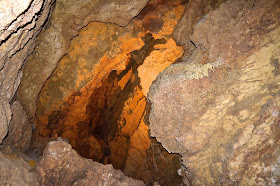
Today, their discovery is recognized as a National Natural Landmark by the U.S. Department of the Interior and one of the world's premier show caverns.
 |
| The Natural Bridge |
More on limestone: MORE
The words stalactite and stalagmite can be traced back to the Greek word "stalassein," which means "to drip." This is fitting because it describes how both are formed in nature. Although they look lifelike and a little creepy, stalactites and stalagmites grow simply because of water running over and through inorganic material.
Limestone caves, where most stalactites and stalagmites are found, are mainly composed of calcite, a common mineral found in sedimentary rocks. Calcite molecules are made of calcium and carbonate ions, and are referred to as CaCO3, or calcium carbonate. When rainwater falls over a cave and trickles through rocks, it picks up carbon dioxide and minerals from limestone.
H20 + CO2 + CaCO3 = Ca (HCO3)2
Ca (HCO3)2 is known as calcium bicarbonate, and the water carries the substance, basically dissolved calcite, through the cracks of the roof of a cave.

Once water comes into contact with the air inside the cave, however, some of the calcium bicarbonate is transformed back into calcium carbonate, and calcite starts to form around the crack.
As water continues to drip, the length and thickness of the calcite grows, and eventually a stalactite forms on the ceiling. It can take a very long time for most stalactites to form. A piece the size of an ice cube takes about 100 years.
Here are some examples of the way we use calcium bicarbonate: USES
Stalagmites grow up from the ground...well, not exactly. The water dripping from the end of a stalactite falls to the floor of a cave and deposits more calcite into a mound. Soon enough, a stalagmite will form in a cone-like shape. This is why you usually find stalactites and stalagmites in pairs, and sometimes they'll even grow together to form one big column.
When you take the tour, find one of the pamphlets located at any local welcome center or convenience store and take advantage of the $2.00 off adults and $1.00 off kids coupons. Wear rubber-soled shoes. Don't overdress. It isn't colder because you are 180 feet under ground. The caverns are kept at a constant 70˚ with a relative humidity of 99%.
Bring your camera. It is lit down there, but a flash will white out the natural colors, so either diffuse it or don't use it.
There are a couple different choices of tours, The Discover Tour
and The Hidden Passages Tour.
Credits:
 |
| 5000 year old evidence of bat tenants. |
 |
| Evidence in Blue |




















Great post! I loved all of the pictures. I had never heard of this cave.
ReplyDeleteThank you Tamsyn. It was a beautiful place. I can only imagine what went through the students' minds when they first encountered it.
ReplyDelete